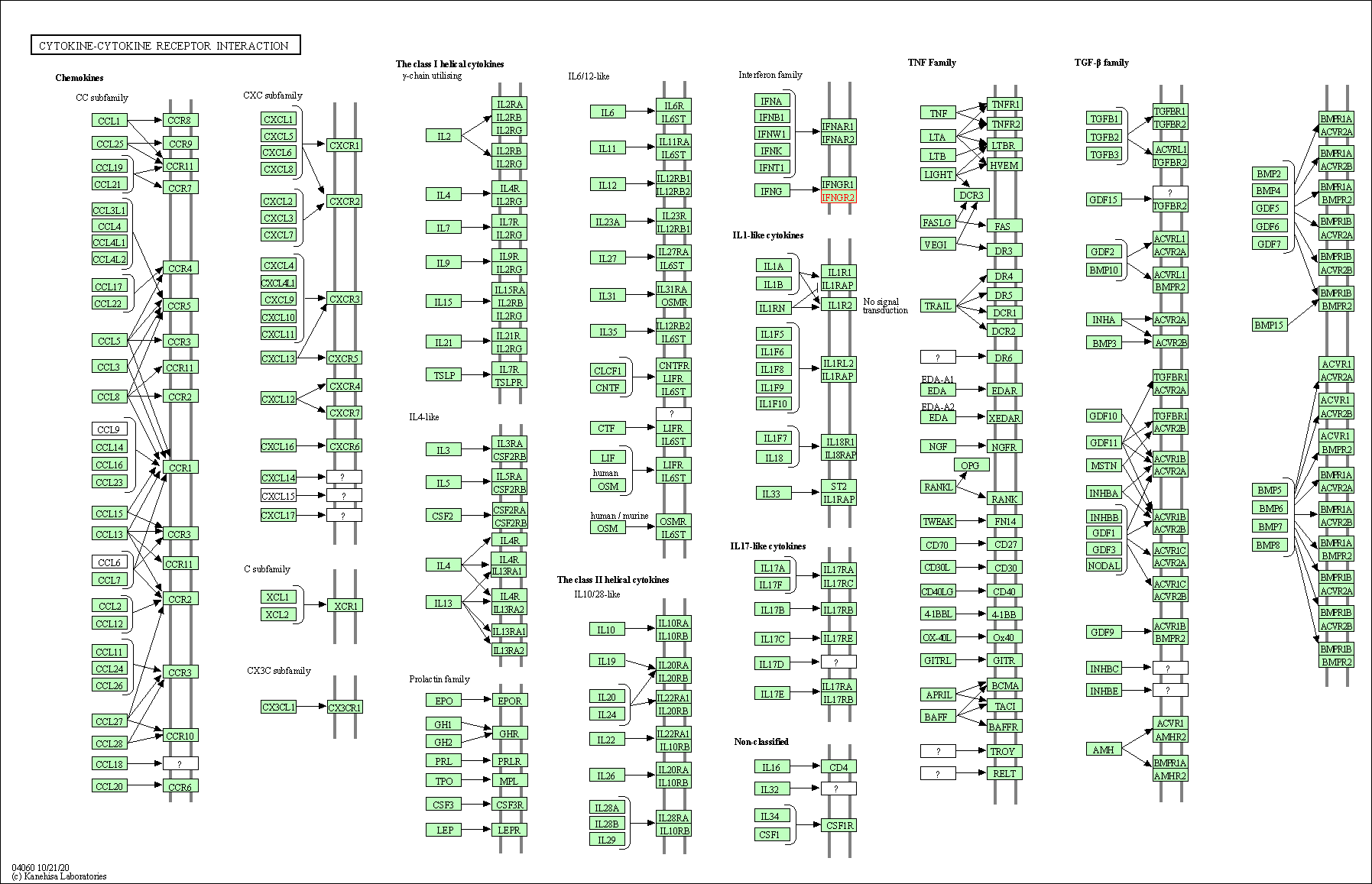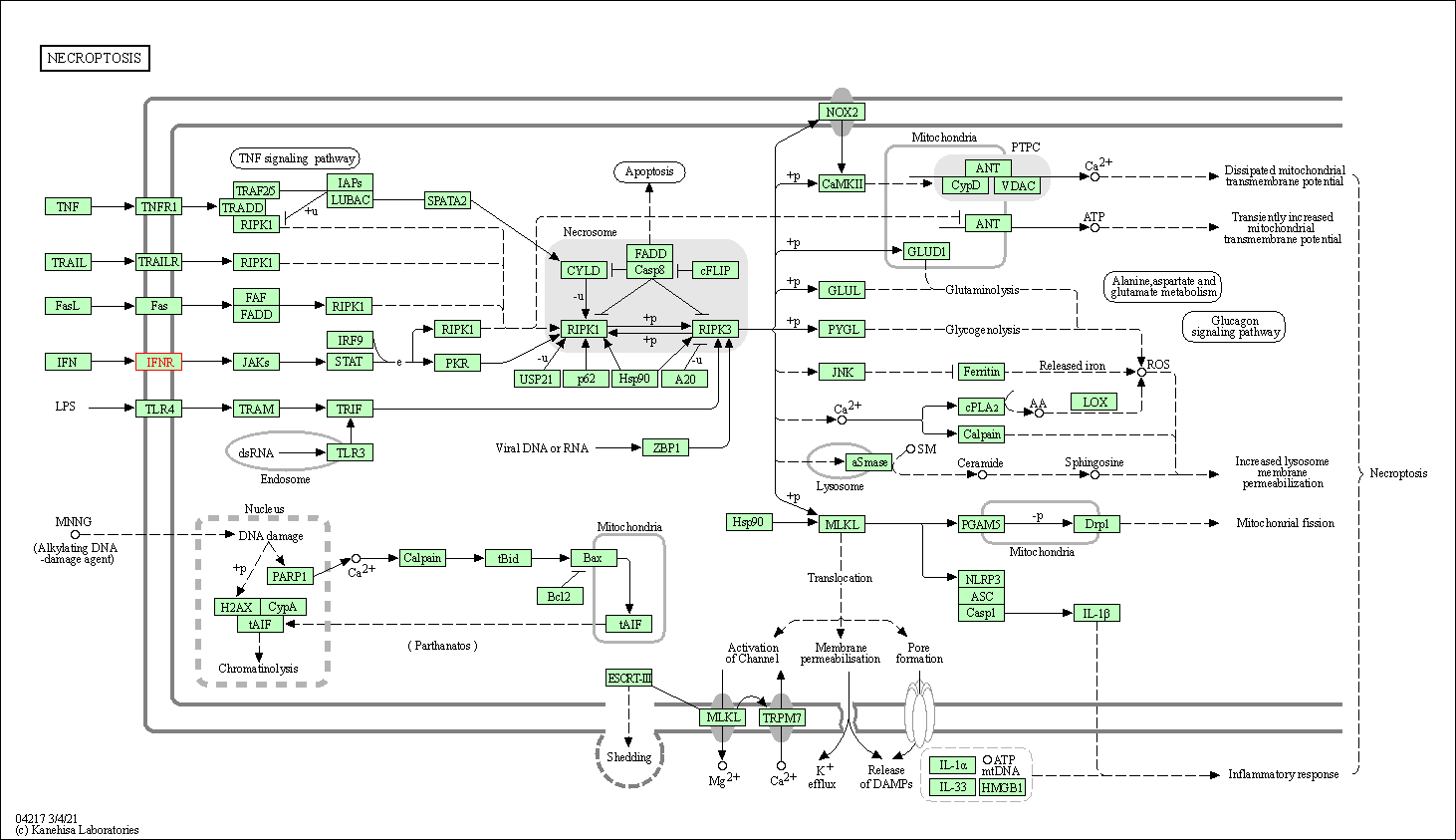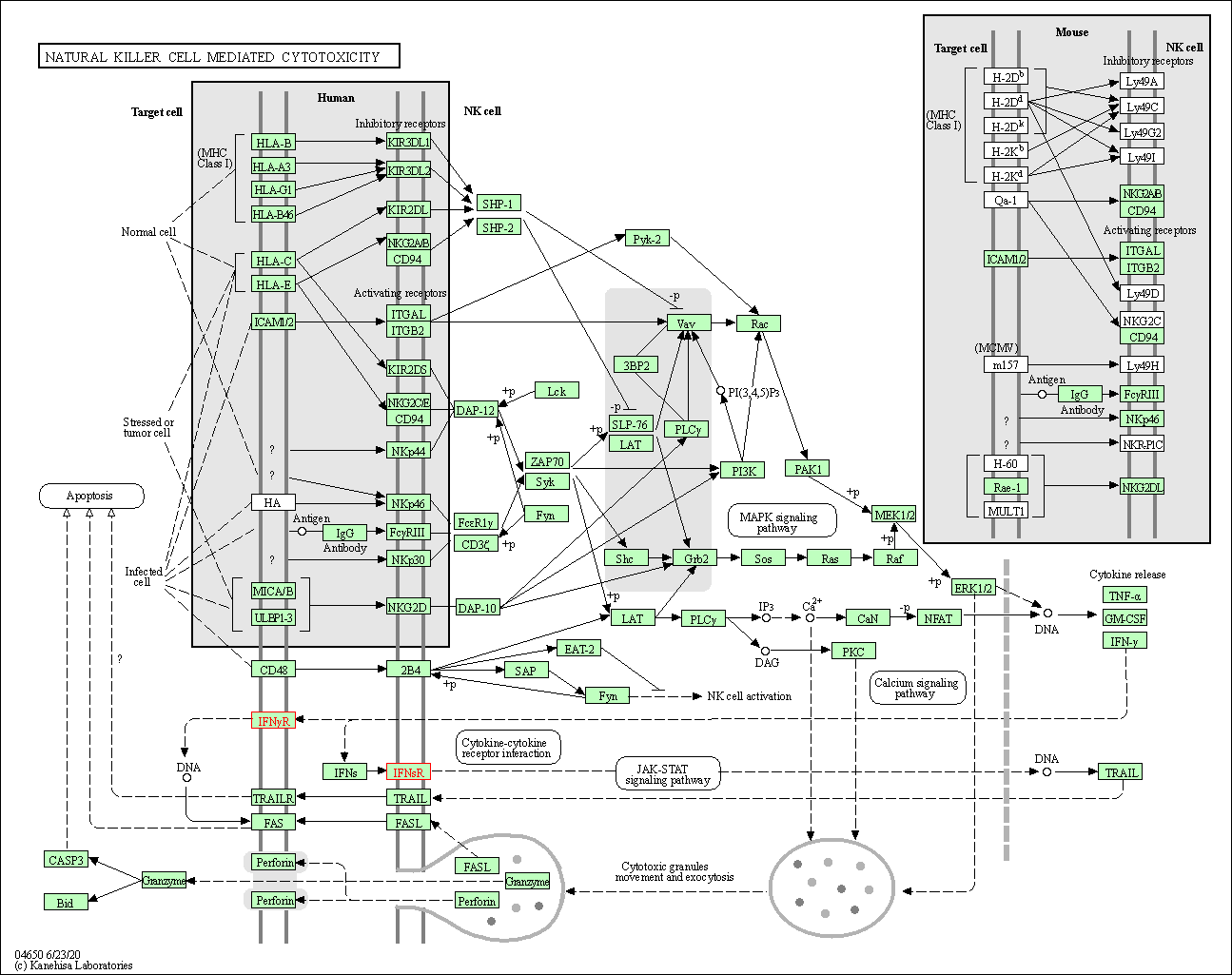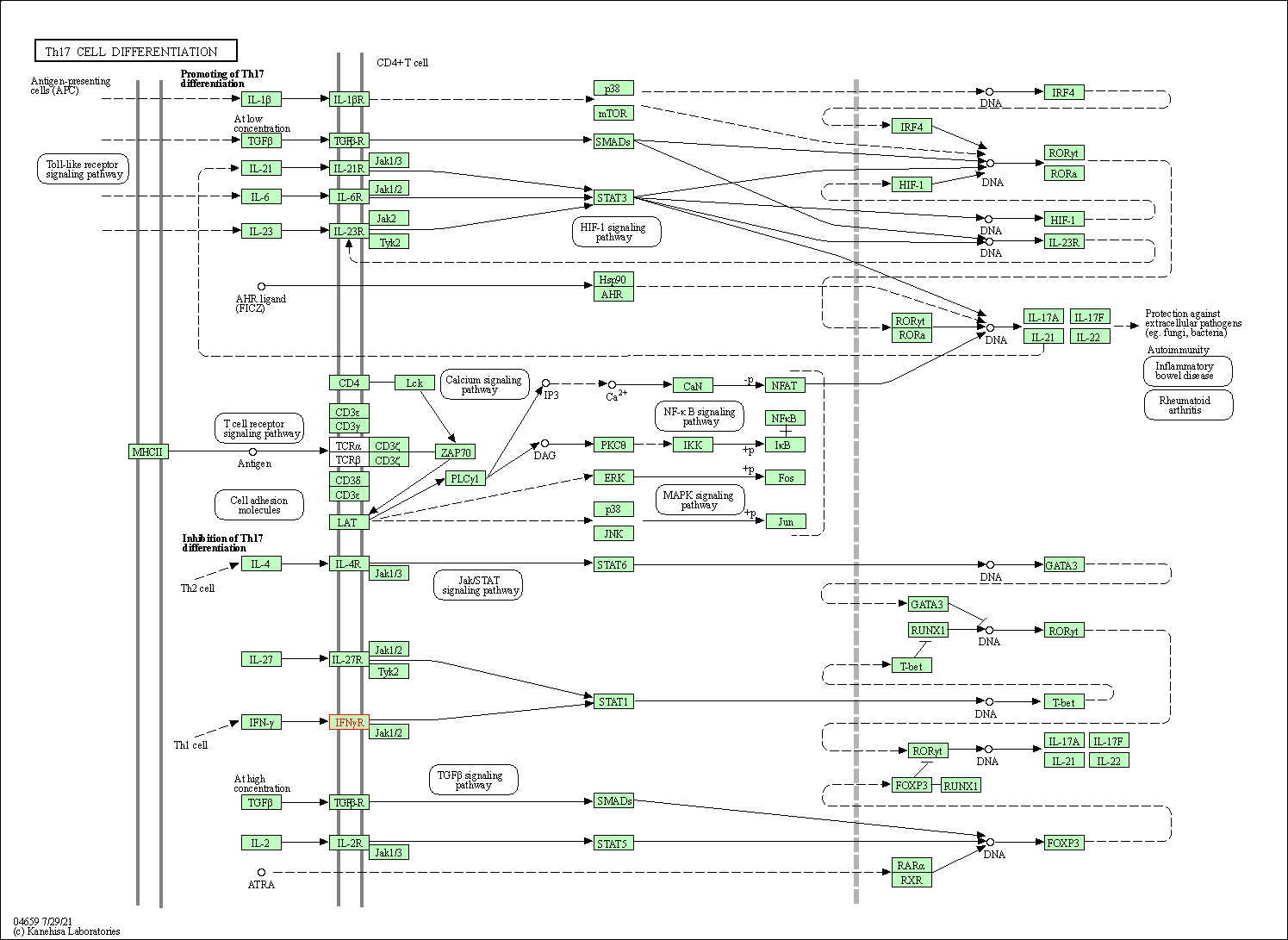Target Information
| Target General Information | Top | |||||
|---|---|---|---|---|---|---|
| Target ID |
T30284
(Former ID: TTDS00477)
|
|||||
| Target Name |
Interferon gamma receptor (IFNGR2)
|
|||||
| Synonyms |
Interferon gamma transducer 1; Interferon gamma receptor beta-chain; Interferon gamma receptor accessory factor 1; Interferon gamma receptor 2; IFNGT1; IFNGR; IFN-gamma-R2; IFN-gamma-R-beta; IFN-gamma-R; IFN-gamma receptor 2; CDw119; CD119; AF-1
Click to Show/Hide
|
|||||
| Gene Name |
IFNGR2
|
|||||
| Target Type |
Successful target
|
[1] | ||||
| Disease | [+] 2 Target-related Diseases | + | ||||
| 1 | Innate/adaptive immunodeficiency [ICD-11: 4A00] | |||||
| 2 | Lupus erythematosus [ICD-11: 4A40] | |||||
| Function |
Ligand binding stimulates activation of the JAK/STAT signaling pathway. Required for signal transduction in contrast to other receptor subunit responsible for ligand binding. Associates with IFNGR1 to form a receptor for the cytokine interferon gamma (IFNG) (, ,).
Click to Show/Hide
|
|||||
| BioChemical Class |
Cytokine receptor
|
|||||
| UniProt ID | ||||||
| Sequence |
MRPTLLWSLLLLLGVFAAAAAAPPDPLSQLPAPQHPKIRLYNAEQVLSWEPVALSNSTRP
VVYQVQFKYTDSKWFTADIMSIGVNCTQITATECDFTAASPSAGFPMDFNVTLRLRAELG ALHSAWVTMPWFQHYRNVTVGPPENIEVTPGEGSLIIRFSSPFDIADTSTAFFCYYVHYW EKGGIQQVKGPFRSNSISLDNLKPSRVYCLQVQAQLLWNKSNIFRVGHLSNISCYETMAD ASTELQQVILISVGTFSLLSVLAGACFFLVLKYRGLIKYWFHTPPSIPLQIEEYLKDPTQ PILEALDKDSSPKDDVWDSVSIISFPEKEQEDVLQTL Click to Show/Hide
|
|||||
| 3D Structure | Click to Show 3D Structure of This Target | AlphaFold | ||||
| Drugs and Modes of Action | Top | |||||
|---|---|---|---|---|---|---|
| Approved Drug(s) | [+] 2 Approved Drugs | + | ||||
| 1 | Anifrolumab | Drug Info | Approved | Systemic lupus erythematosus | [2] | |
| 2 | Interferon gamma-1b | Drug Info | Approved | Chronic granulomatous disease | [3] | |
| Mode of Action | [+] 2 Modes of Action | + | ||||
| Antagonist | [+] 1 Antagonist drugs | + | ||||
| 1 | Anifrolumab | Drug Info | [2] | |||
| Binder | [+] 1 Binder drugs | + | ||||
| 1 | Interferon gamma-1b | Drug Info | [1], [4] | |||
| Cell-based Target Expression Variations | Top | |||||
|---|---|---|---|---|---|---|
| Cell-based Target Expression Variations | ||||||
| Different Human System Profiles of Target | Top |
|---|---|
|
Human Similarity Proteins
of target is determined by comparing the sequence similarity of all human proteins with the target based on BLAST. The similarity proteins for a target are defined as the proteins with E-value < 0.005 and outside the protein families of the target.
A target that has fewer human similarity proteins outside its family is commonly regarded to possess a greater capacity to avoid undesired interactions and thus increase the possibility of finding successful drugs
(Brief Bioinform, 21: 649-662, 2020).
Human Tissue Distribution
of target is determined from a proteomics study that quantified more than 12,000 genes across 32 normal human tissues. Tissue Specificity (TS) score was used to define the enrichment of target across tissues.
The distribution of targets among different tissues or organs need to be taken into consideration when assessing the target druggability, as it is generally accepted that the wider the target distribution, the greater the concern over potential adverse effects
(Nat Rev Drug Discov, 20: 64-81, 2021).
Human Pathway Affiliation
of target is determined by the life-essential pathways provided on KEGG database. The target-affiliated pathways were defined based on the following two criteria (a) the pathways of the studied target should be life-essential for both healthy individuals and patients, and (b) the studied target should occupy an upstream position in the pathways and therefore had the ability to regulate biological function.
Targets involved in a fewer pathways have greater likelihood to be successfully developed, while those associated with more human pathways increase the chance of undesirable interferences with other human processes
(Pharmacol Rev, 58: 259-279, 2006).
Biological Network Descriptors
of target is determined based on a human protein-protein interactions (PPI) network consisting of 9,309 proteins and 52,713 PPIs, which were with a high confidence score of ≥ 0.95 collected from STRING database.
The network properties of targets based on protein-protein interactions (PPIs) have been widely adopted for the assessment of target’s druggability. Proteins with high node degree tend to have a high impact on network function through multiple interactions, while proteins with high betweenness centrality are regarded to be central for communication in interaction networks and regulate the flow of signaling information
(Front Pharmacol, 9, 1245, 2018;
Curr Opin Struct Biol. 44:134-142, 2017).
Human Similarity Proteins
Human Tissue Distribution
Human Pathway Affiliation
Biological Network Descriptors
|
|
| Protein Name | Pfam ID | Percentage of Identity (%) | E value |
|---|---|---|---|
| Protein-tyrosine phosphatase sigma (R-PTP-sigma) | 23.729 (42/177) | 7.40E-04 |
|
Note:
If a protein has TS (tissue specficity) scores at least in one tissue >= 2.5, this protein is called tissue-enriched (including tissue-enriched-but-not-specific and tissue-specific). In the plots, the vertical lines are at thresholds 2.5 and 4.
|








| KEGG Pathway | Pathway ID | Affiliated Target | Pathway Map |
|---|---|---|---|
| Cytokine-cytokine receptor interaction | hsa04060 | Affiliated Target |

|
| Class: Environmental Information Processing => Signaling molecules and interaction | Pathway Hierarchy | ||
| HIF-1 signaling pathway | hsa04066 | Affiliated Target |

|
| Class: Environmental Information Processing => Signal transduction | Pathway Hierarchy | ||
| Necroptosis | hsa04217 | Affiliated Target |

|
| Class: Cellular Processes => Cell growth and death | Pathway Hierarchy | ||
| Osteoclast differentiation | hsa04380 | Affiliated Target |

|
| Class: Organismal Systems => Development and regeneration | Pathway Hierarchy | ||
| JAK-STAT signaling pathway | hsa04630 | Affiliated Target |

|
| Class: Environmental Information Processing => Signal transduction | Pathway Hierarchy | ||
| Natural killer cell mediated cytotoxicity | hsa04650 | Affiliated Target |

|
| Class: Organismal Systems => Immune system | Pathway Hierarchy | ||
| Th1 and Th2 cell differentiation | hsa04658 | Affiliated Target |

|
| Class: Organismal Systems => Immune system | Pathway Hierarchy | ||
| Th17 cell differentiation | hsa04659 | Affiliated Target |

|
| Class: Organismal Systems => Immune system | Pathway Hierarchy | ||
| Click to Show/Hide the Information of Affiliated Human Pathways | |||
| Degree | 4 | Degree centrality | 4.30E-04 | Betweenness centrality | 6.70E-08 |
|---|---|---|---|---|---|
| Closeness centrality | 2.03E-01 | Radiality | 1.35E+01 | Clustering coefficient | 8.33E-01 |
| Neighborhood connectivity | 3.58E+01 | Topological coefficient | 3.76E-01 | Eccentricity | 12 |
| Download | Click to Download the Full PPI Network of This Target | ||||
| Target Affiliated Biological Pathways | Top | |||||
|---|---|---|---|---|---|---|
| KEGG Pathway | [+] 14 KEGG Pathways | + | ||||
| 1 | Cytokine-cytokine receptor interaction | |||||
| 2 | HIF-1 signaling pathway | |||||
| 3 | Osteoclast differentiation | |||||
| 4 | Jak-STAT signaling pathway | |||||
| 5 | Natural killer cell mediated cytotoxicity | |||||
| 6 | Salmonella infection | |||||
| 7 | Leishmaniasis | |||||
| 8 | Chagas disease (American trypanosomiasis) | |||||
| 9 | Toxoplasmosis | |||||
| 10 | Tuberculosis | |||||
| 11 | Measles | |||||
| 12 | Influenza A | |||||
| 13 | Herpes simplex infection | |||||
| 14 | Inflammatory bowel disease (IBD) | |||||
| Reactome | [+] 2 Reactome Pathways | + | ||||
| 1 | Interferon gamma signaling | |||||
| 2 | Regulation of IFNG signaling | |||||
| WikiPathways | [+] 2 WikiPathways | + | ||||
| 1 | Type II interferon signaling (IFNG) | |||||
| 2 | Interferon gamma signaling | |||||
| Target-Related Models and Studies | Top | |||||
|---|---|---|---|---|---|---|
| Target Validation | ||||||
| References | Top | |||||
|---|---|---|---|---|---|---|
| REF 1 | Genetic polymorphisms in the promoter of the interferon gamma receptor 1 gene are associated with atopic cataracts. Invest Ophthalmol Vis Sci. 2007 Feb;48(2):583-9. | |||||
| REF 2 | FDA Approved Drug Products from FDA Official Website. 2021. Application Number: 761123. | |||||
| REF 3 | Natural products as sources of new drugs over the last 25 years. J Nat Prod. 2007 Mar;70(3):461-77. | |||||
| REF 4 | Interferon-gamma 1b for the treatment of idiopathic pulmonary fibrosis. Expert Opin Biol Ther. 2006 Oct;6(10):1051-60. | |||||
If You Find Any Error in Data or Bug in Web Service, Please Kindly Report It to Dr. Zhou and Dr. Zhang.

